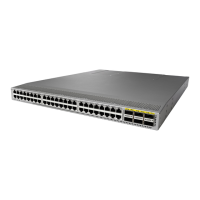• Configure the syslog as an EEM publisher.
• Verify your EEM configuration.
Configuring Action Statements
You can configure an action by using one of the following commands in EEM configuration mode
(config-applet):
If you want to allow a triggered event to process any default actions, you must configure the EEM policy to
allow the default action. For example, if you match a command in a match statement, you must add the
event-default action statement to the EEM policy or EEM does not allow the command to execute. You can
use the terminal event-manager bypass command to allow all EEM policies with matches to execute the
command.
Note
Before you begin
Define a user policy.
Procedure
PurposeCommand or Action
Runs the configured commands. You can
optionally run the commands on the module
where the event occurred.
action number[.number2] cli
command1[command2.] [local]
Example:
Step 1
The action label is in the format
number1.number2.
switch(config-applet) # action 1.0 cli
"show interface e 3/1"
The number can be any number from 1 to 16
digits.
The range for number2 is from 0 to 9.
Modifies the counter by the configured value
and operation.
action number[.number2] counter name
counter value val op {dec | inc | nop | set}
Step 2
Example:
The action label is in the format
number1.number2.
switch(config-applet) # action 2.0
counter name mycounter value 20 op inc
The number can be any number from 1 to 16
digits.
The range for number2 is from 0 to 9.
The counter can be any case-sensitive,
alphanumeric string up to 28 characters.
The val can be an integer from 0 to 2147483647
or a substituted parameter.
Cisco Nexus 3548 Switch NX-OS System Management Configuration Guide, Release 7.x
127
Configuring Embedded Event Manager
Configuring Action Statements

